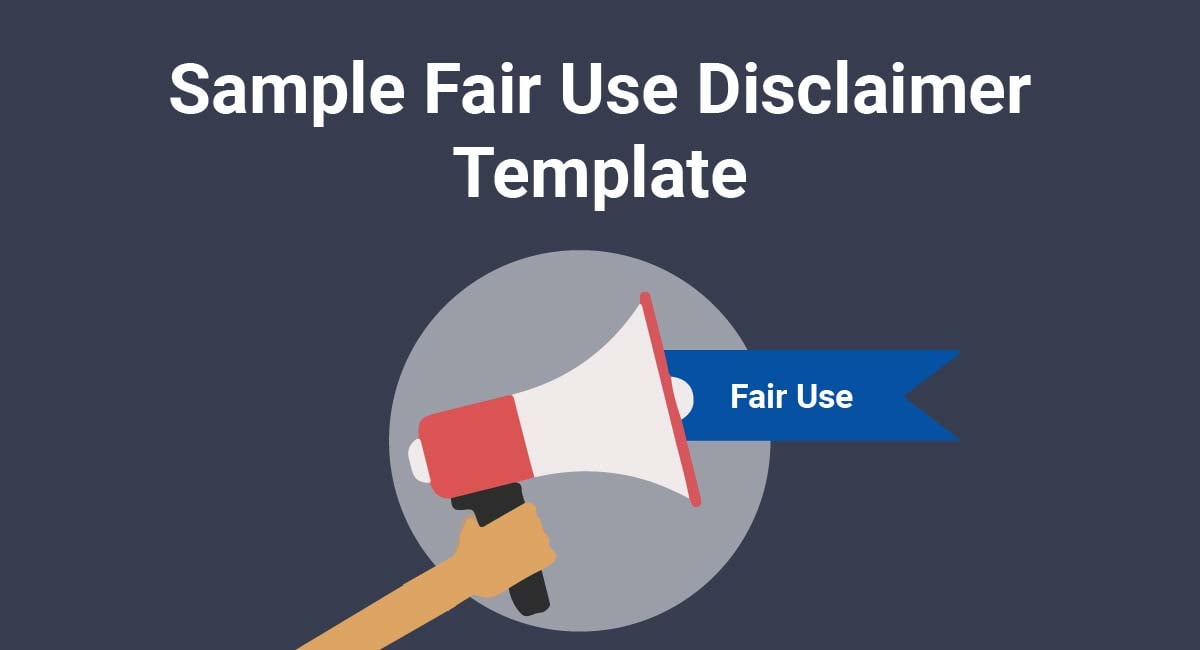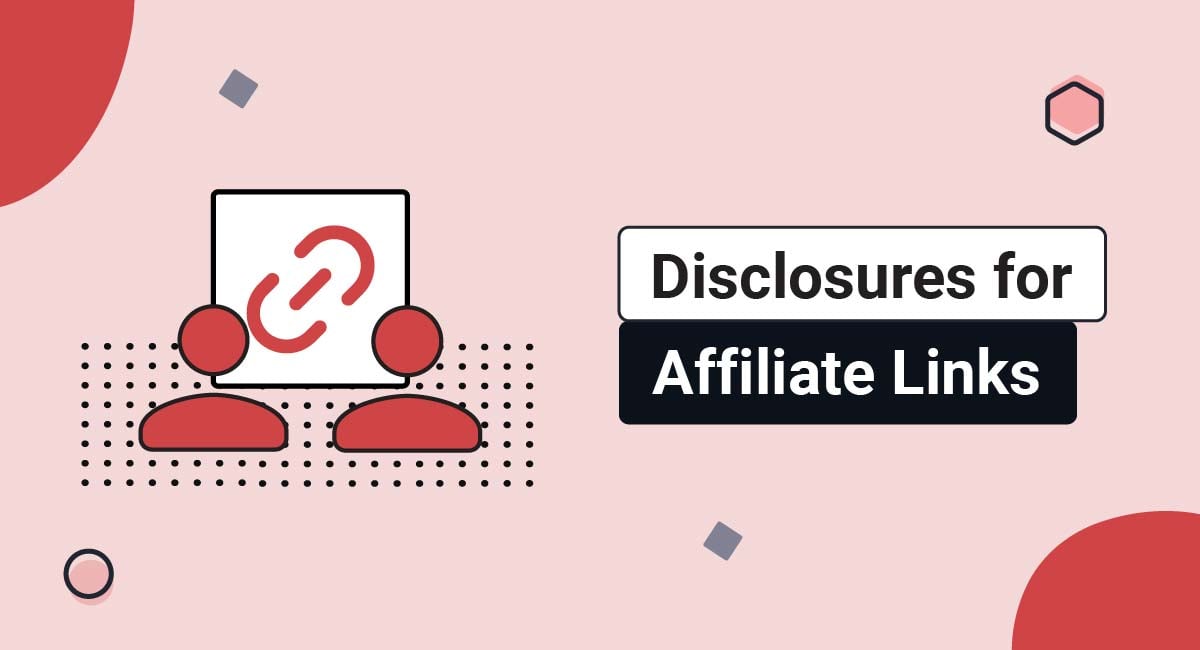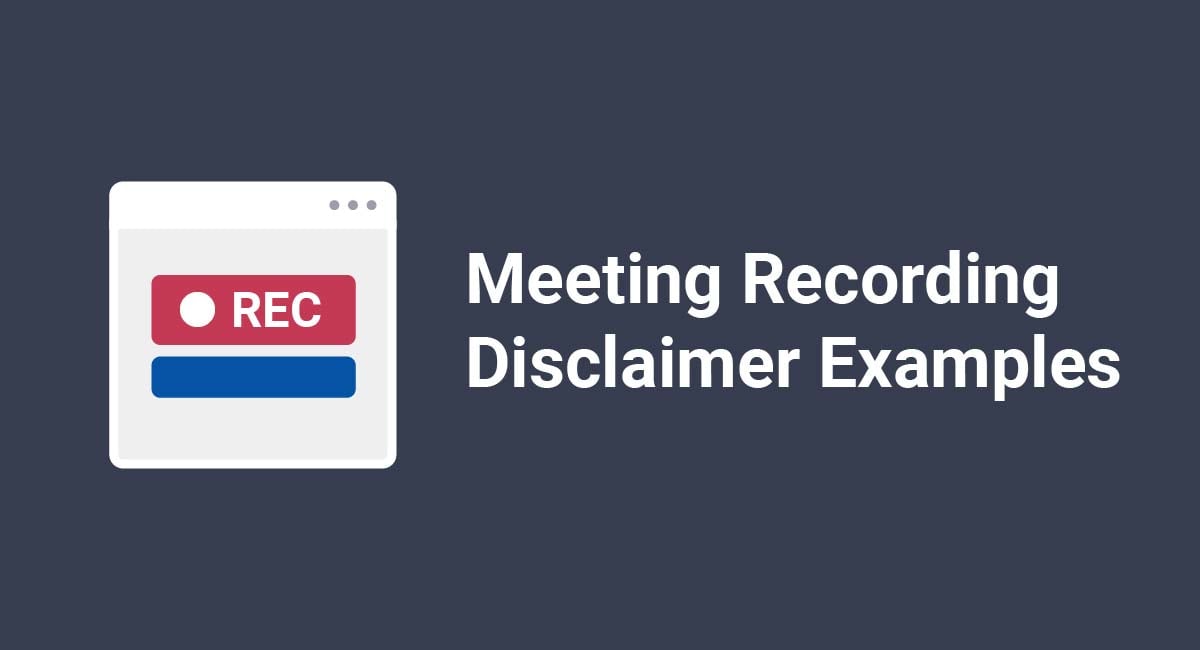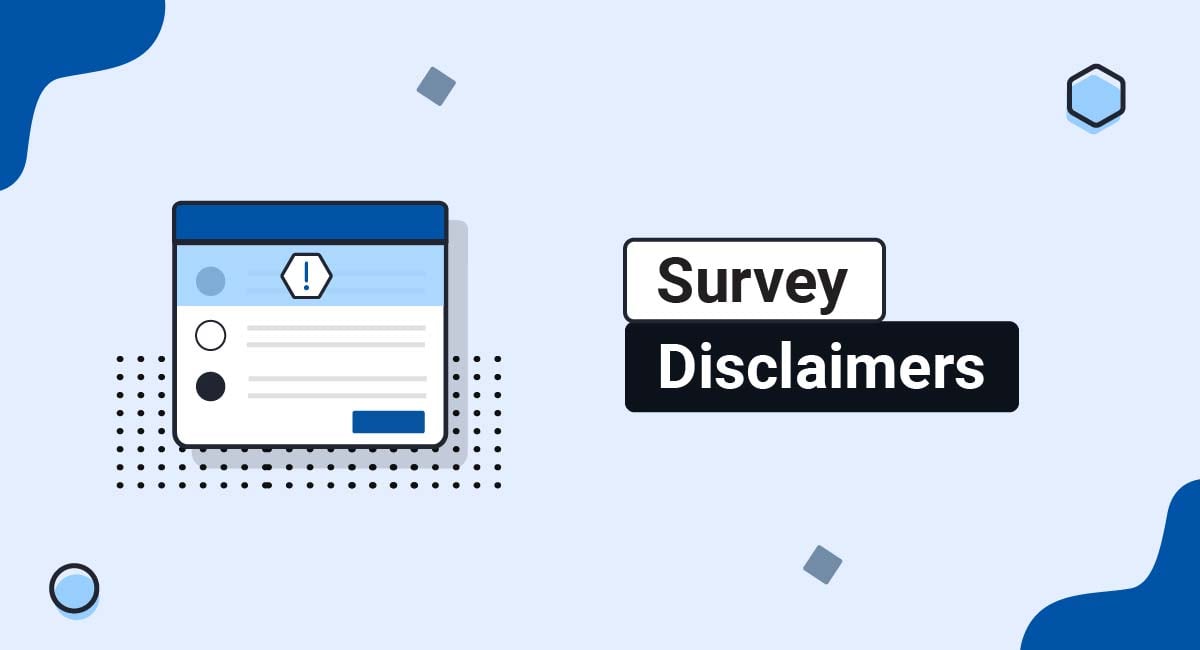Fair use disclaimers let the reader know that although you're using copyrighted materials without the permission of the copyright's owner, you're still using those materials legally.
These disclaimers have a lot of value for creators because they can deter copyright holders from legal action. Cease and desist letters, threats from lawyers, and even litigation over fair use can create huge and costly headaches for creators online. A fair use disclaimer can prevent any of that from happening, allowing you to relax and focus on the work that matters.
This article will further define this type of disclaimer, and show you how to write and display your own.
Our Disclaimer Generator can generate a legal disclaimer for your business, website or mobile app. Just follow these steps:
-
At Step 1, select where your Disclaimer will be used.
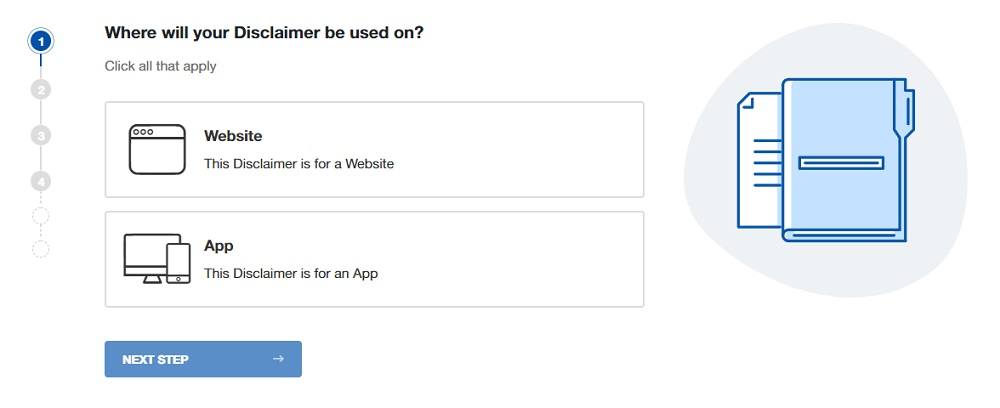
-
At Step 2, add in information about your website/app and business.
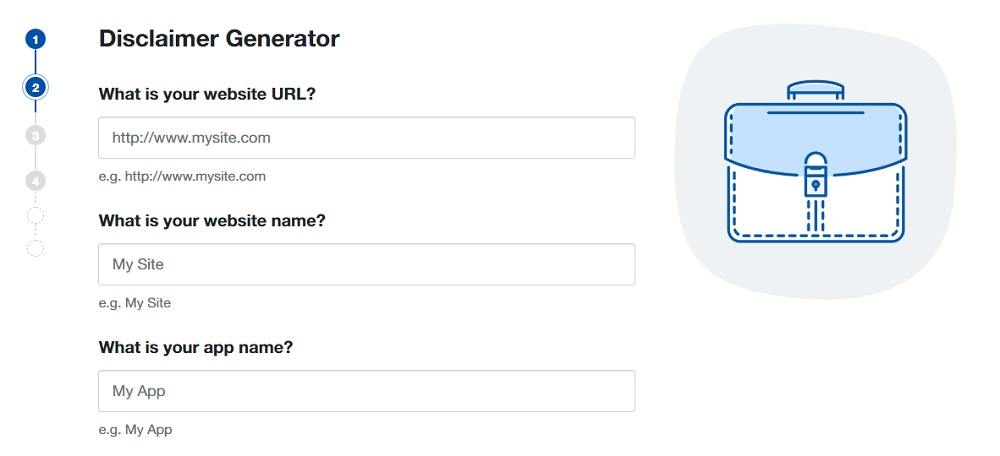
-
Answer some questions about your business practices.
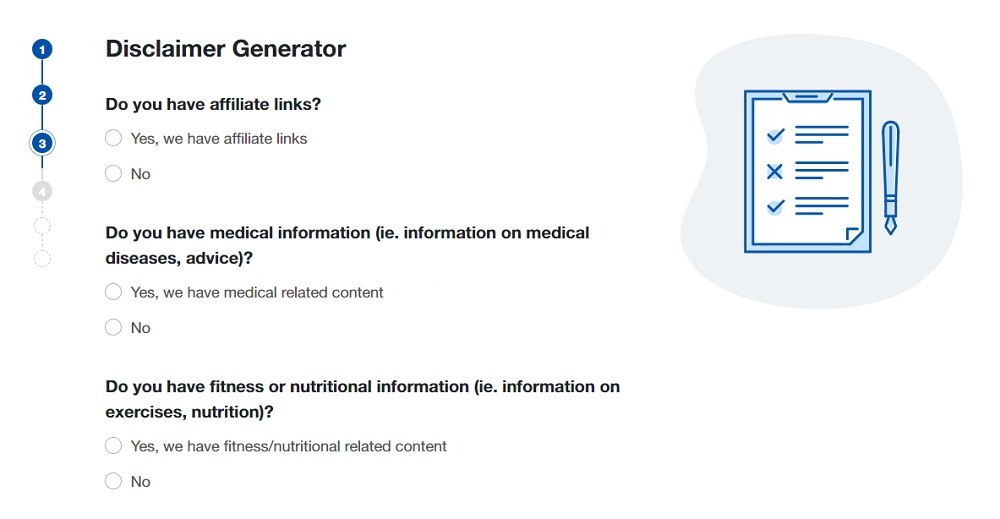
-
Enter an email address where you'd like to receive your Disclaimer and click "Generate."
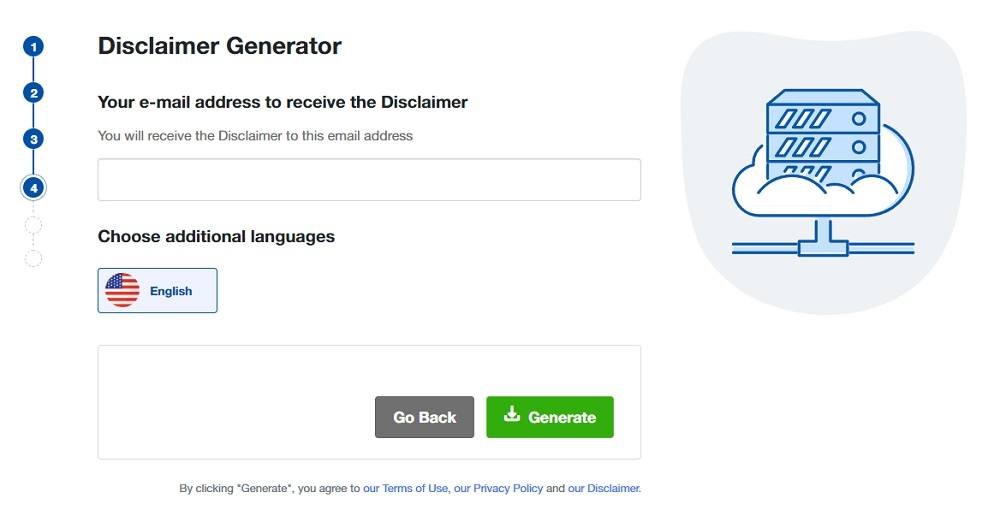
Done! You'll be able to instantly access and download your new Disclaimer.
- 1. What's a Fair Use Disclaimer?
- 2. Do I Need a Fair Use Disclaimer?
- 3. Fair Use and the Law
- 3.1. Four Statutory Factors of Fair Use
- 3.1.1. Purpose and Character of Use
- 3.1.2. Nature of the Original
- 3.1.3. How Much of the Work Was Used
- 3.1.4. Value of the Effects
- 4. How to Write a Fair Use Disclaimer
- 4.1. Use of Copyrighted Materials
- 4.2. Purpose for Using Copyrighted Materials
- 4.3. Cite the Law
- 4.4. More Information on Fair Use
- 4.5. Others' Use of Copyrighted Materials
- 5. Examples of Fair Use Disclaimers
- 6. Where to Display a Fair Use Disclaimer
- 7. Summary
- 8. Download Sample Fair Use Disclaimer Template
- 8.1. More Disclaimer Templates
What's a Fair Use Disclaimer?

A fair use disclaimer is a statement letting people know when you're engaging in a practice known as "Fair Use."
Simply put, a fair use disclaimer says that your site or material includes copyrighted materials that you may not have the license to use.
Fair use can be a tricky topic for people who create content online. But no matter whether you're using copyrighted materials on your personal website, in YouTube videos, or in your music, you should make sure to use a fair use disclaimer.
Fair use disclaimers limit your liability with regard to using others' copyrighted material. There are cases where you can legally use copyrighted works without getting permission from the owners of those works. This is called fair use, and a fair use disclaimer lets readers know that you may be using some copyrighted material under fair use.
You can use materials under fair use as long as you don't take credit for the copyrighted work and you use it in a transformative way.
For example, the relevant law says that "criticism, comment, news reporting, teaching (including multiple copies for classroom use), scholarship, or research, is not an infringement of copyright" and all of those uses would fall under fair use.
Of course, there are uses outside of those examples that are also protected by fair use, such as parody. That's why it's important to use a fair use disclaimer to clarify how your use is justified under fair use.
Do I Need a Fair Use Disclaimer?

If you're using copyrighted materials in a way that's covered by fair use, you need a fair use disclaimer. It doesn't just create a record that you're using these materials appropriately, it also deters others from claiming otherwise.
A fair use disclaimer is a written record that you are using copyrighted works under fair use. If there were ever a dispute about your use of those works, it would be an important piece of evidence establishing that you were using them fairly. It would also support your claim that others who might take issue with your use were already aware that you were claiming fair use.
In that way, it deters others from pursuing legal action around your use of copyrighted materials. It communicates to them that you understand your right to use this material the way that you're using it, and may take action to defend yourself if accused of misusing it. It also specifies why your use of the materials qualifies under fair use, clearing up any confusion the owners of a copyrighted work might have.
Accusations and more serious legal actions can create a serious problem for small creators without large budgets for legal fees. You shouldn't underestimate the power of a deterrent to save you headaches and money.
Of course, a fair use disclaimer doesn't help you in court if your use doesn't actually qualify under fair use. Before you put a fair use disclaimer up, you should make sure you're using copyrighted materials correctly under fair use.
Fair Use and the Law

The entirety of the fair use clause in U.S. Copyright law can be found in US Code 17 107 - Limitations on exclusive rights: Fair use.
Fair use is centered on four statutory factors as well as the "transformativeness" of the use of the work. Let's take a look at these factors.
Four Statutory Factors of Fair Use
According to the law, there are four factors that guide fair use:
- The purpose and character of the use, such as whether the use is commercial in nature or for nonprofit educational purposes
- The nature of the copyrighted work
- The amount and sustainability of the used portion compared to the copyrighted work itself as a whole
- Any effect that the use has on the potential market for or value of the copyrighted work
Let's break these four factors down.
Purpose and Character of Use
Where and how you intend to use the copyrighted work is important because the law and courts favor uses that aren't designed to make money off the source.
Education, research, reporting, commentary, and criticism - those common uses listed above - are favored by fair use policies because the work is reaching a wider audience but the second user isn't profiting significantly from it.
Fair use becomes more complicated when the use becomes mixed. While educational purposes are favored, for-profit universities may not find themselves on the right side of the law when using copyrighted material without seeking permission. This is because although the material is used for teaching, the school makes a profit.
Nature of the Original
Was the original work published? Copyrighted? Listed in any way?
You may not realize it, but working with someone else's published and copyrighted materials is easier than working with someone else's unpublished work. Making private work public doesn't mesh well with copyright law because it isn't "fair," particularly in the sense of fair use.
You're more likely to struggle with this when you're dealing with creative material: using someone's unpublished song, video, or writing without permission. Factual work is more likely to stand up in court.
How Much of the Work Was Used
Using a small amount of the work, or a sample, is more likely to be fair than taking a larger portion or the entire work.
Use is also proportional. For example, if you're writing a 3,000 word article and you use a 40-word quote from a book, the law might recognize that you're not using the quote to sell your article. It's buried deep inside the article.
Let's build on this point. Using copyrighted material under fair use is fairer when you're not relying on the source as the foundation of what you're doing. If you're borrowing the work, it will be much easier to argue it is fair use because you can still argue it is transformative rather than that you're simply repackaging the work for your own use.
Value of the Effects
Will the work you borrowed make you a significant amount of money or garner prestige or market share from the owner of the original material? If so, you may be violating fair use.
Assessing the value of the potential effect of the work is difficult, particularly in the internet age when a borrowed work may go viral without intention or expectation.
Still, there's a simple way to look at it: Will your use of the work rob the creator of a sale? If so, you may be violating fair use.
Looking for an example of how complicated fair use can be? Look no further than the music industry.
How to Write a Fair Use Disclaimer

A fair use disclaimer can be brief or lengthy, depending on your personal preferences. With these examples and explanations, you can decide for yourself which parts are relevant for your purposes.
You should also pay attention to the particular justifications each of these creators is claiming under fair use, which can also influence how their fair use disclaimer is written.
Use of Copyrighted Materials
Of course, for there to be a claim of fair use, you must be using copyrighted works. That's why many fair use disclaimers begin with a statement that the site may be using copyrighted materials without the owner's permission.
This part of the disclaimer is a good opportunity to give some more specifics about the copyrighted materials you may be using. You'll want to keep this broad so that it applies to all the materials you may use right now or in the future. However, some specificity here can help narrow down which materials may be copyrighted.
You should also clarify that the relevant copyrighted materials are ones that you don't already have permission to use. After all, the ones you have a license or permission for don't need to be justified under fair use.
You can see how the NCECA does this below. It opens by saying that there may be copyrighted materials within the resources on the website. Then it states that the use of some of those materials may not have been authorized by the owner of the copyright:

Previously, it specified that the resources are presentation slides from a conference. This checks all the boxes for what you may want to include in this part of the disclaimer.
Purpose for Using Copyrighted Materials
The beginning of a fair use disclaimer is a natural place to not only state that you are using materials under fair use, but also why you're using them.
Explaining this has two purposes. Legally, it can establish part of your justification for fair use. Secondly, it can also make a reader (and potential litigant) more sympathetic to your purposes and less likely to pursue legal action.
Under U.S. fair use law, certain purposes are explicitly protected as fair use. If your use of copyrighted materials qualifies under fair use in that way, it's a good idea to point that out as soon as you can.
That's exactly what the Oregon Center for Public Policy does in its Fair Use Policy. It states that making the specific material available is a part of the efforts to educate others, and explains that it believes it constitutes a "fair use" of the material:
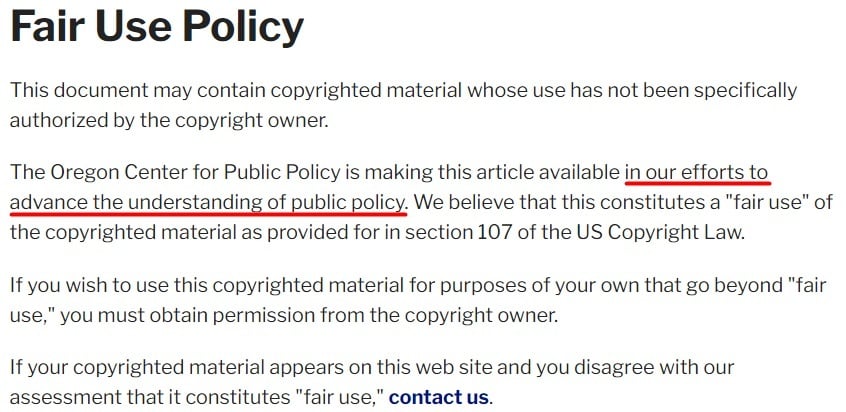
It can also be a good idea to spell your purposes out a little more and attempt to evoke sympathy with the reader. While this isn't legally distinct from the approach above, it takes the extra step of explaining the purpose in more detail.
The National Whistleblower Center spells out its intentions in this portion of its Fair Use Notice. By listing a series of intentions that some audiences may be sympathetic to, legal conflicts may be avoided:

Cite the Law
An important part of any fair use disclaimer is that you cite the relevant law. In this case, it's pretty simple. You just need to refer to U.S. Code 17 107 - Limitations on exclusive rights: Fair use.
Specifically, you need to note that you believe your use of any copyrighted material that you don't have permission to use is justified under this law.
There are multiple ways of referring to the law.
The Institute of Black Imagination refers to it twice, in two different ways. First, it refers to section 107 of the U.S. Copyright Law, a more informal way of citing a law. Then, it gives the full name of the statute, Title 17 U.S.C. Section 107.
It's not essential that you name the law both ways, but you should at least give the full name of the relevant statute. That will make sure there isn't any confusion about the law if someone tries to search for it. It also shows your familiarity with the law, in the case that you may need to defend yourself:

More Information on Fair Use
Many fair use disclaimer include additional information on fair use. This can either be in the form of a link to more information or an additional section providing that information. By providing more information, they both prove their own knowledge of the law and possibly inform others about fair use, preventing potential legal action.
Giving more information about fair use proves your own knowledge of the law. As with many other parts of a fair use disclaimer, this serves to deter copyright holders from taking legal action against your website. It shows just how familiar you are with your own rights, and that you are unlikely to buckle under legal intimidation from cease and desist letters or threats of litigation.
It also provides an opportunity for copyright holders to learn about fair use. Some owners of copyrighted material may not know that you can use their work legally, so providing them this information might actually change their minds about whether to pursue legal action against you.
Remember, not everyone is familiar with U.S. copyright law, so this could save you from some major headaches in the future.
One way to give some additional information about fair use is by linking to a resource with that information. As long as you're using a reliable source, you don't have to worry about giving an explanation in your own words, so this might be the more comfortable option if you aren't a legal expert yourself.
It's what Mass Equality chooses to do in its Fair Usage Policy, where it cites the Cornell Law School's Legal Information Institute, a reliable source:

Instead of linking to another resource, you may choose to write out information about fair use yourself. This has the advantage of delivering the information straight to the reader, but you should be cautious here.
Unless you're an expert, you may still want to rely on outside resources for your fair use justification.
Others' Use of Copyrighted Materials
A final, optional part of a fair use disclaimer is a simple sentence stating that if others want to use copyrighted materials, they have to get permission from the copyright owner. This is meant to prevent others from unintentionally using copyrighted materials incorrectly by copying them from your site but not using them in ways that qualify as fair use.
You can see an example of this from the Choices Natural Market website below:

Now that you know what content should go into your disclaimer, let's take a look at some places where you should make your disclaimer available to the public.
Examples of Fair Use Disclaimers

Writing a fair use disclaimer is fairly straightforward, but it should always be tailored to the kind of content you borrow and how you use it. Ideally, you'll find a way to express how this fits in with Section 107 of the U.S. Copyright Law.
We've put together a few examples to show you how standard yet customized your fair use disclaimer can be.
In its disclaimer, Mass Equality notes its non-profit mission which is friendly to fair use, and its belief that its use of material falls within the law. An external link to the law has been added for authority and to demonstrate understanding:

Mass Equality goes one step further and tells users that if they want to use the already-transformed materials in ways that may go beyond fair use, then they need copyright permission from the source - not from Mass Equality.
The clause removes further liability from the non-profit by clearly stating that it's not involved in the further dissemination of material that extends beyond the law or beyond its site.
If your business or site serves as a platform where others may routinely share material, you still need some kind of protection.
Critical Media Project has a fair use statement where it defines what fair use is and then explains how it feels it has created "a transformative use of copyrighted media" and has done so "as a way to advance research and teaching related to critical media literacy and intercultural understanding, among other salient political and social issues."
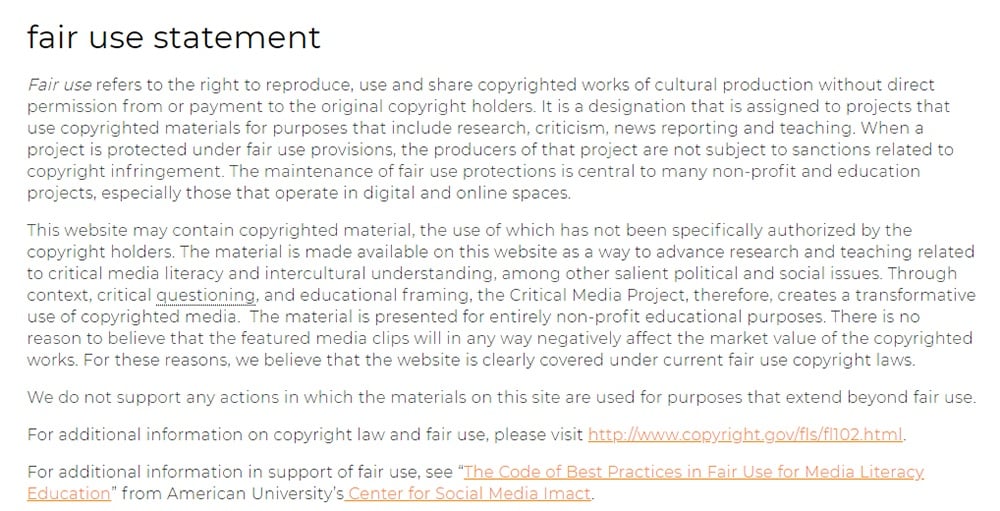
It also notes at the bottom that it doesn't support any actions that take the materials on the site and use them for purposes beyond fair use.
Compare this rather in-depth and detailed fair use statement with this shorter one from JOST that simply says the site is for "educational purposes only."
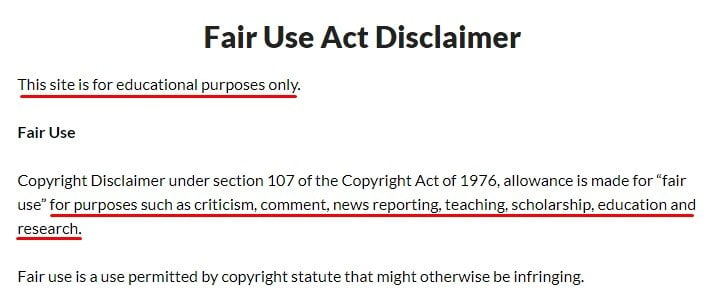
Some businesses put their fair use disclaimer in with other disclaimers and legal content, such as this Fair Use and Content Disclaimer from NCECA. This combines the fair use information with disclaimers related to comments and opinions expressed:
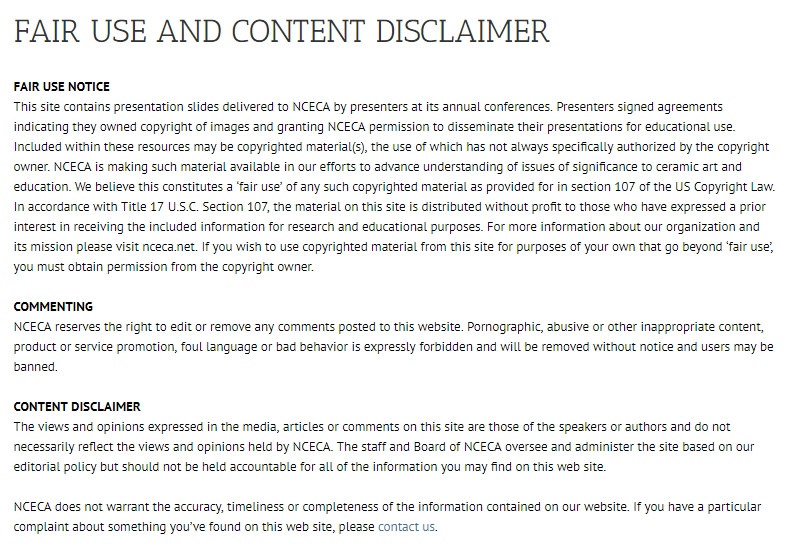
YouTube is a prime example of a site that hosts content uploaded by users who may have borrowed or sampled copyrighted or previously unpublished works.
In its Fair Use guidelines, YouTube notes that different rules are applied worldwide and provides a free audio library with content that can be reused safely:
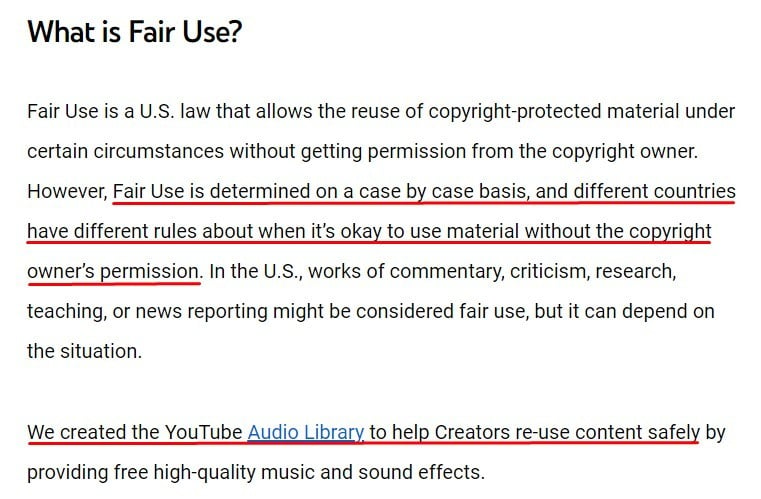
Fair use disclaimers inform visitors of all kinds that you're using someone else's work, but you're using it in a way that's "transformative."
You didn't repurpose or repackage it to make money off of it, so let this be known. These disclaimers show that you're honest, know the law and they can help protect you from legal action.
Where to Display a Fair Use Disclaimer

Depending on how you're using copyrighted materials, you may want to display your fair use disclaimer in different ways. Two of the most common uses are for YouTube videos and websites, both situations where people often rely on copyrighted content and have a lot to lose if they aren't able to use it anymore.
For a personal website, it's a good idea to give your fair use disclaimer its own page, which users can easily navigate to.
For example, CUInsight includes a disclaimer on its "Copyright & Use" page, which is linked at the bottom of every page on the website. The link is near other, similar content such as the Terms of Service:
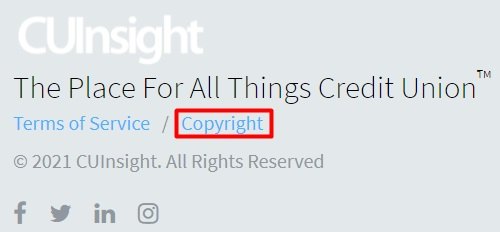
If you make YouTube videos that may contain copyrighted content, it's a good idea to include a fair use disclaimer in the descriptions of your videos. This can be below other links and content in the description but should include the basic components mentioned above.
You can see an example below from a YouTube channel that makes videos using copyrighted content from a video game:

Summary
A fair use disclaimer can help you avoid expensive legal action and inform copyright owners about your right to use their work. Anyone who uses copyrighted content in ways that qualify under fair use should use disclaimers like these.
Fair use disclaimers can vary depending on your preferences, but there are five main components to consider including in yours:
- Description of your use of copyrighted materials
- Your purpose for using those materials
- The name of the relevant law for fair use
- More information about fair use
- Recommendations for others considering taking copyrighted content from your website
Download Sample Fair Use Disclaimer Template
Our Sample Fair Use Disclaimer Template will be available soon.
More Disclaimer Templates
More specific Disclaimer Templates are available on our blog.
| Sample Disclaimer Template | A Disclaimer for all sorts of businesses. |
| Sample App Disclaimer Template | A Disclaimer for mobile apps. |
| Testimonial Disclaimer Sample | A Disclaimer for testimonials. |
| Sample Warranty Disclaimer Template | A Disclaimer of warranties. |

Comprehensive compliance starts with a Privacy Policy.
Comply with the law with our agreements, policies, and consent banners. Everything is included.
